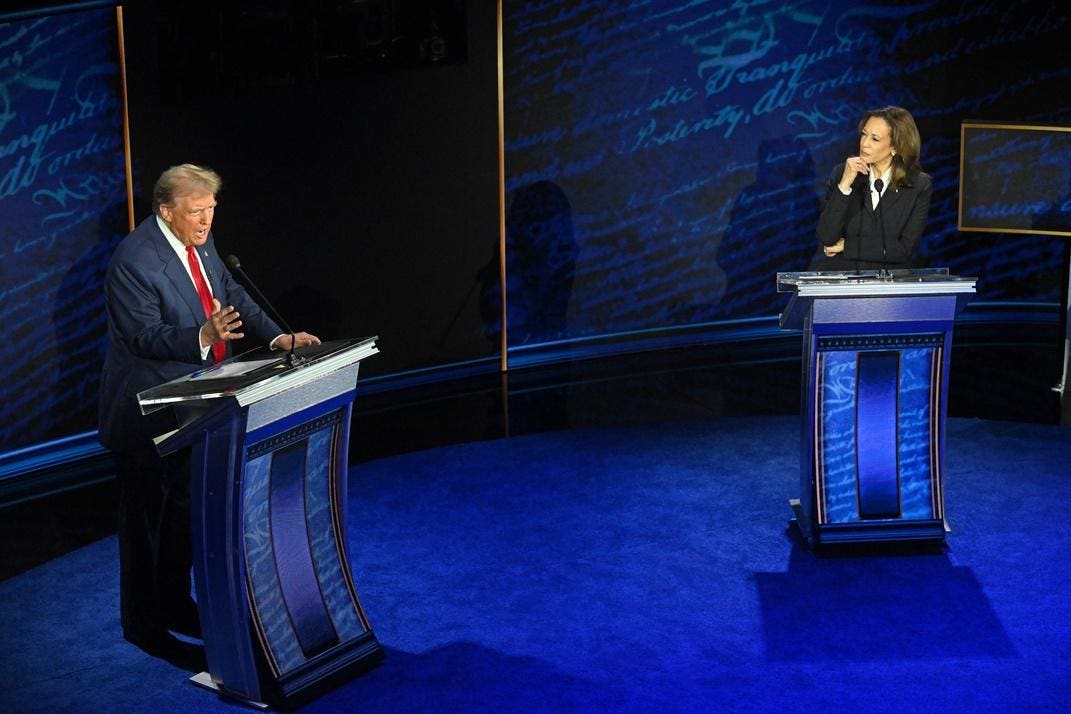
Even before the first—and likely only—presidential debate between Vice President Kamala Harris and former President Donald Trump ended, misinformation and even disinformation were being shared on social media. In the hours that followed, however, it was fake accounts promoted misleading and factual incorrect content.
According to the disinformation security firm Cyabra, 18% of the debate-related conversations on X were driven by fake accounts, generating more than 30,000 engagements and 57 million potential views. Those fake accounts—many of which were only created this year—used hashtags like #debate2024 and #presidentialdebate2024 to maximize their visibility. Those accounts pushed a false narrative that ABC provided Vice President Harris with the debate questions.
“Our post-debate analysis reveals a disturbing rise in the scale and sophistication of disinformation tactics around the Trump-Harris debate,” warned Dan Brahmy, CEO of Cyabra.
“Fake accounts, many launched this year, and AI-generated content drove 18% of the conversation on social media, spreading false narratives demonstrates a clear intention to manipulate public opinion and influence the 2024 election,” Brahmy continued. “False claims like links between immigration policies and pet safety—still managed to capture significant engagement. These coordinated efforts underscore the vulnerability of political discourse and highlight the urgent need for stronger defenses against disinformation.”
Election Interference
This election cycle has seen a steady uptick in misinformation and disinformation campaigns being directed by foreign actors to undermine confidence in the outcome of the election. The post-debate commentary is just part of these efforts, which will continue up to and even following Election Day.
“Countries like Russia, China, and Iran, among others, are trying to influence the US election, one way or another. Social media is the optimal space to do that. Agents of these countries need only to enter existing echo chambers and magnify the message that serves them best. In part, social media platforms have become vehicles through which division can be sewn cheaply and efficiently. Fake profiles spreading misinformation are part of those efforts,” explained Dr. Julianna Kirschner, lecturer at the Annenberg School for Communication and Journalism at the University of Southern California.
Though the Cyabra research found that the influx of misinformation may have favored the former president, there has been no shortage of misinformation that has been favorable toward the vice president. Instead of actually trying to get one candidate elected, the efforts seem to be directed at dividing Americans.
“On social media, there are certainly cases of expanding division in the U.S. in which one candidate is favored over another,” added Kirschner. “Many efforts have been shown to have this dual purpose. To divide voters, these echo chambers must magnify the rhetoric of a selected candidate. Usually in absolute terms, these decidedly fake profiles assert claims that can be easily debunked.”
Yet, research has also shown the more users are exposed to such misleading content, the more likely they will believe the falsehoods.
“This is especially prevalent when users are predisposed to accept messages at face value due to their adherence to shared value systems,” said Kirschner. “In other words, when fake profiles say what users want to hear, they are primed to listen to anything else the fake profiles distribute, no matter how absurd.”
Campaigns Of Hate
Another purpose of the misinformation and disinformation campaigns is to make Americans look at their neighbors with suspicion. Social media has also become a 21st century form of “yellow journalism” that offers the sensation over facts and could endanger those in the immigrant community.
Just as there was misinformation about Asians during the pandemic, there is now anti-immigrant rage that those coming into the country are eating pets and geese from city parks.
“For many people, pets are as sacred as family members, so outrage is likely to follow when myths about immigrants eating them are spread,” said Kirschner. “Likewise, the supposed New York voodoo rituals have created a sense of exoticism and unfamiliarity, which lead to evocative fear. It is fear of the unknown that drives these campaigns on social media. Fear motivates for the wrong reasons, which is why adversaries use this approach often on these platforms. Until users can discern when they are being manipulated, these traps will become more and more common.”
Moreover, the real fear that Americans should be feeling right now is that the platforms are doing so little to combat this spread of misinformation/disinformation.
“We should be concerned,” said technology industry analyst Roger Entner of Recon Analytics. “Especially since Twitter/X is not reigning in deliberate misinformation in a meaningful way.”
This post was originally published on this site be sure to check out more of their content







